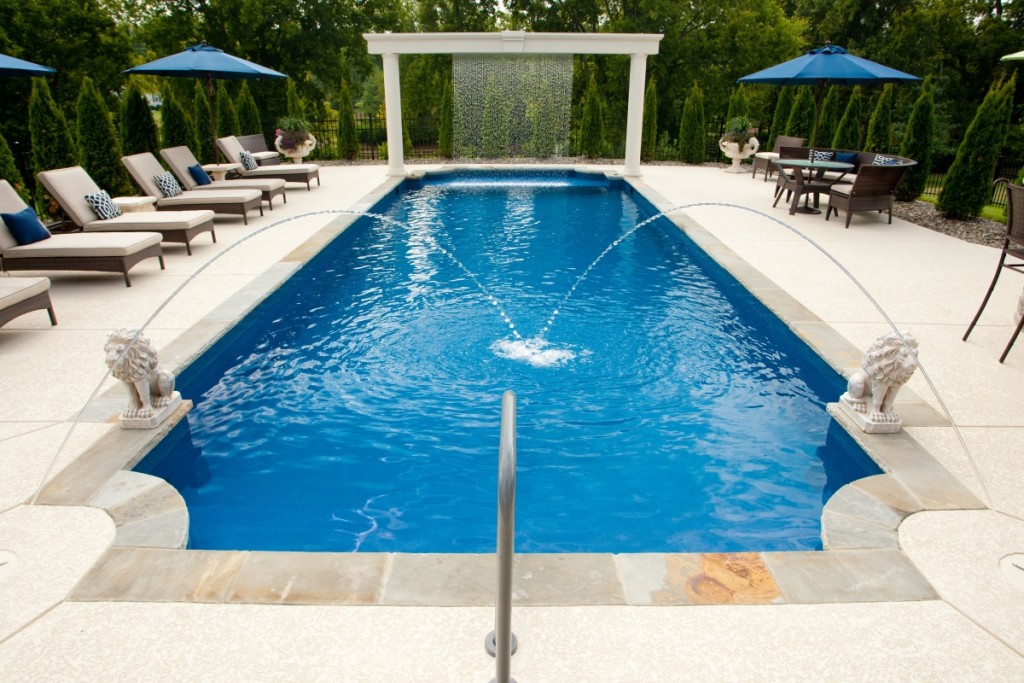Fiberglass Pool Problems come in two varieties: myths, and actual concerns.
Some fiberglass pool problems are based on facts, and what an experienced pool contractor really watches out for when installing an inground pool of any size or shape. Others are simply exaggerated tales of agony and despair meant to sway your pool choice away from certain materials that are used when building a pool.
Can a fiberglass pool pop up?
We hear this question a lot. There’s an air of sensationalism surrounding a pool owners misfortune when facing a pool renovation. The truth is that any kind of pool whether it’s fiberglass, vinyl, or concrete, can pop up and out of it’s hole. The reason a pool can float has to do with trapped water building up pressure underneath the pool, with nowhere to go. The hole essentially becomes a pond. The increase in water pressure turns the pool into a boat, and it will do what a boat does best….float. The technical term for this condition is hydrostatic pressure.
The solution to prevent any kind of pool from floating is proper installation. One way for a pool builder to install a pool and permanently prevent it from floating is to add a hydrostatic pressure relief valve in the hole. This valve allows water to escape before it builds up enough pressure underneath the pool to damage it. Another way is to install a construction liner that goes under the pool and is tied to the pool pump. This line can be turned on if the pool ever needs to be drained to relieve any hydrostatic pressure, if it exists.
Fiberglass pools should also have a cantilevered concrete edge around the rim of the pool. The concrete edge acts as a collar to hold the fiberglass pool in place, if you ever need to drain and service the pool. A Fiberglass pool should always have water in it. The water inside the pool weighs it down, and keeps everything locked in place. You should very rarely have to drain a pool.
Why does a fiberglass pool cost more than vinyl liner pool?
There are a couple of ways to look at this question. Initial pool construction cost, and long term maintenance cost. When comparing the cost of a fiberglass pool to a vinyl liner one, adjustments need to be made for the accessories and features you want included with the installation. Once those are backed out, a fiberglass pool usually runs a few thousand dollars more. Fiberglass could range between $4,000 to $11,000 more than vinyl in upfront cost.
The difference is in the long term cost. A vinyl liner pool typically needs maintenance around the 6th or 7th year of installation. The environment around the pool & how well it’s maintained affect how often the vinyl would need to be replaced. An average liner replacement costs around $4,000 dollars. Assuming you own the pool for about 15 years, you’re looking at $8,000 in maintenance over that time period.
Do fiberglass pools look cheap?
This is truly a myth with today’s fiberglass pool technology. Modern advancements have made fiberglass a premium material that matches up beautifully with luxury trim options, and modern accessories. We’ll answer this question for you with one of our fiberglass pool projects:

Fiberglass Pool Problems Video Transcript:
| Interviewer: | Jay, can you tell me a little bit about fiberglass pool problems and maybe some common misconceptions about them? Something we had discussed before was a lot of people asking question about why fiberglass pools would float?
|
| Jay Tucker: | Yeah. Absolutely. A lot of times people will hear from different folks in the industry that a fiberglass pool is something that you shouldn’t consider because they can float, float out of the ground. Absolutely, that is correct. You could take that pool, take it out to our local lake and put a motor on the back of it and drive it around the lake if you wanted to do that. The answer is, that can it float? Absolutely, it can. A concrete pool can float as well because when it’s all said and done, it’s a one-piece vessel, and then a vinyl liner can actually float. All type pools have potential water issues, and so the main thing is to understand that those are concerns and then also how to deal with it.
|
| We deal with it, and all three type of pools we do, but especially the fiberglass. Because of that misconception, we put a system in that can take that water away if you ever have to drain the water in the pool, and so which brings up a point, is as long as there’s water inside that pool, is that it’s not going to get enough hydraulic ground water pressure to push up to float that pool out of there. Where the opportunity is, is that if the pool is empty and we get torrential rains and the ground water table rise, there’s water underneath there. That hydraulic pressure can push it and make that pool come out of the ground, but 99% of the time, there’s water always going to be in that swimming pool.
|
|
| Interviewer: | I see, so it really is an issue of water being underneath the pool, that if you don’t mitigate that situation, then it cause issues with the pool.
|
| Jay Tucker: | Exactly right. That’s exactly right.
|